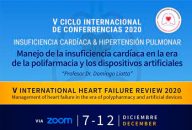In pulmonary hypertension (PHT), 10 mg macitentan plus 40 mg tadalafil is recommended as a safe combination therapy for newly diagnosed patients or in a significant proportion of patients during follow-up. Using a tablet with a fixed drug combination (FDC) could simplify treatment. The aim of this study was to evaluate the efficacy and safety of macitentan/tadalafil…
We Should Start Considering Pulmonary Hypertension After TAVR
Pulmonary hypertension is associated with higher mortality after both aortic valve replacement and transcatheter aortic valve replacement (TAVR). This is a dynamic phenomenon, and what happens after TAVR —during the periprocedure— and its impact are yet to be evaluated. Researchers conducted a subanalysis of the Japanese OCEAN TAVI Registry, which included 1872 patients who were divided…
Discount for SOLACI Members – V Heart Failure Review 2020
On December 7 thru 12 SOLACI is holding the 5th International Round of Conferences 2020 on “Heart Failure and Pulmonary Hypertension: Management of hear failure in times of polypharmacy and artificial devices”. The event will take place next week Monday thru Friday from 5 to 7 pm and Saturday 12 from 10 to 12 am…
Negative Impact of Pulmonary Hypertension in TAVR
Courtesy of Dr. Carlos Fava. The presence of pulmonary hypertension (PH) is frequent in severe aortic stenosis. This can be classified in: isolated pre-capillary PH, isolated post-capillary PH, and combined post-capillary and pre-capillary PH. At present, little research has looked into the disease from this perspective. The study looked at 1400 patients and divided them…
Pulmonary Hypertension: No Reason for TAVR Contraindication
In most severe aortic stenosis patients with pulmonary hypertension, transcatheter aortic valve replacement (TAVR) reduced pulmonary systolic pressure. There patients presented lower risk and lower all-cause mortality at short, median and long term. This data show that pulmonary hypertension should not be a TAVR contraindication. Pulmonary hypertension is common among TAVR patients. The most frequent…
Pulmonary Artery Denervation Starts to Show Results
Pulmonary artery denervation is associated with significant hemodynamics improvement, as well as improved clinical outcomes in patients with both post and precapillary pulmonary hypertension. Even though there are several studies on this technique, they included few patients (with different criteria and different devices), which is why we need more randomized studies. This prospective, randomized, study…
Balloon Angioplasty: A Reasonable Plan B for Chronic Thromboembolic Hypertension
Thromboembolic pulmonary hypertension is caused by pulmonary artery stenosis caused by organized thrombi. The only treatment potentially healing for this disease is surgical thrombectomy. However, patients with lesions in very peripheral branches or high surgical risk patients with comorbidities might benefit from a plan B, such as balloon pulmonary angioplasty. The percentage of patients with chronic…





